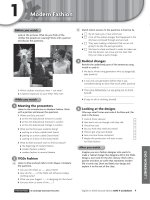4 1 early americans
Bạn đang xem bản rút gọn của tài liệu. Xem và tải ngay bản đầy đủ của tài liệu tại đây (4.24 MB, 10 trang )
Fascinating Facts
• Chumash people used fishhooks hundreds
of years ago.
• The Chumash paddled their canoes so far
out in the ocean that sometimes they lost
sight of land.
• Chumash hunters used wooden decoys to
hunt ducks.
Genre
Nonfiction
Comprehension Skill
Text Features
Main Idea and Details • Map
• Sidebars
Scott Foresman Social Studies
ISBN 0-328-14852-0
ì<(sk$m)=beifcd< +^-Ä-U-Ä-U
In this book, you will read about the
Chumash people. The Chumash lived in
southern California and on a group of islands
off the California coast. They were among
the first people to live in the region.
Write to It!
The Chumash depended on the land and the
sea for food. In a short paragraph, describe
one way in which the Chumash obtained a
food supply.
Vocabulary
culture
hereditary
Write your paragraph on a separate sheet of
paper.
site
mission
missionary
Maps
3 Mapquest.com
Photographs
Every effort has been made to secure permission and provide appropriate credit for photographic material. The publisher deeply
regrets any omission and pledges to correct errors called to its attention in subsequent editions.
Unless otherwise acknowledged, all photographs are the property of Scott Foresman, a division of Pearson Education.
Photo locators denoted as follows: Top (T), Center (C), Bottom (B), Left (L), Right (R) Background (Bkgd)
ISBN: 0-328-14852-0
Copyright © Pearson Education, Inc. All Rights Reserved. Printed in the
United States of America. This publication or parts thereof, may be used with appropriate
equipment to reproduce copies for classroom use only.
1 2 3 4 5 6 7 8 9 10 V0G1 14 13 12 11 10 09 08 07 06 05
Opener: ©David Muench/Corbis
Editorial Offices: Glenview, Illinois • Parsippany, New Jersey • New York, New York
4 ©Marilyn “Angel” Wynn/Nativestock
8 ©Marilyn “Angel” Wynn/Nativestock
Sales Offices: Needham, Massachusetts • Duluth, Georgia • Glenview, Illinois
11 ©David Muench/CorbisCoppell, Texas • Sacramento, California • Mesa, Arizona
13 ©Chuck Place Photography
14 ©Corbis
American Indians is a term that is used
to describe the first people who lived in this
land. You may have heard of the Navajo, the
Apache, the Cheyenne, and the Sioux. These
are well-known American Indian groups. The
Chumash lived in California. Their culture
played a major role in the settling of early
California.
OREGON
Key
Present-day
national border
Present-day
state border
NEVADA
CALIFORNIA
PACIFIC OCEAN
ARIZONA
American Indian Names
Many places in the United States
have American Indian names. You may
have heard the names Massachusetts,
Delaware, and Huron. These are the
names of two states and a Great
Lake. All three of these names are of
American Indian origin.
2
Chu
Ch a n n
N
0
0
100
100
ma
sh
el I
sla
nd
s
MEXICO
200 Miles
200 Kilometers
This map of coastal California shows where the
Chumash lived.
3
The Early Chumash
A Village Chief
Before the Spanish arrived in California, the
Chumash lived along the south central coast of
California. They lived in a connected group of
villages. They had contact with other American
Indians in the western part of the country.
The very first Chumash villages had only a
few houses and contained no more than sixty
people. As time passed, the population grew.
Each village had a chief. The Chumash
had a class system, and the title of chief was
hereditary. It was passed down from a parent
to a child.
A chief was expected to be honest, strong,
good at hunting and fishing, and able to get
along with people. The chief often had to settle
arguments. As the villages became larger, it was
sometimes necessary for a chief to declare war.
4
5
What the Chumash Ate
The Chumash ate meat, fish, and wild plant
parts. Oak trees provided the Chumash with
acorns. All of the plant parts used by the
Chumash for food were gathered, not grown.
The Chumash were not farmers.
After they gathered the acorns, Chumash
women would grind the nuts into flour. Acorn
flour was used to make different types of food,
such as breadlike loaves.
6
The Chumash had uses for other plants. They
dug up a plant called soaproot. They used it
as a shampoo and for washing their skin and
clothing. They also made brushes out of it. These
brushes could be used as tools for preparing
food or for cave painting. Best of all, they ate it.
After being roasted in an oven the bulbs made
delicious treats.
The Chumash had uses for every part of a
plant. They knew what to do with the flowers,
stems, leaves, seeds, roots, and bulbs.
7
Chumash Boats
The Chumash lived on the mainland and on
the Channel Islands. They needed a way to go
back and forth between the mainland and the
islands.
The Chumash built plank canoes called
tomols. The boat was made from planks cut from
driftwood. The planks were sewn together. Then
the joints were sealed with pitch, or tar. After
the canoes were finished, they were painted red
and decorated with seashells.
Fishing and Hunting
Most Chumash men were fishermen.
Sometimes they fished from their canoes
with a hook and line. Other times they
used fish traps, spears, clubs, and nets
to catch fish.
The Chumash hunted animals such
as deer, elk, antelope, rabbits, and
squirrels. The Chumash were very quiet
hunters. Wearing animal skins often
helped Chumash hunters to close in on
their prey without being noticed.
9
Ceremonies and Fiestas
Chumash Cave Paintings
The Chumash loved celebrations. The winter
solstice, or the shortest day of the year, was the
most important celebration.
Three people had special duties at Chumash
celebrations. They were the chief, the shaman,
or religious leader, and the paxa. One of the
chief’s main duties was to make sure that there
was enough food. The paxa was in charge of
the festival. The paxa chose the site for the
special dances. He made sure that everything
went smoothly.
A shaman was a religious leader. This can be
seen in the rock paintings that have been found
in mountain caves. Because of the paintings’
locations, many believe that only a shaman was
allowed in the caves.
The Chumash cave paintings have many
different patterns. One Chumash painting
shows a ship. Others look like figures based on
heavenly bodies.
This is an example of a Chumash cave painting.
10
11
Baskets and Tools
The Chumash made some of the finest baskets
ever created. The baskets were made using plants
similar to tall reeds. The Chumash wove designs
into the fibers. These baskets have lasted for
centuries and can be seen in many museums.
The Chumash made interesting tools. They made
knives, scrapers, and arrowheads by grinding and
sharpening different types of stone. Fishing hooks
were made from the shells of clams and other
shellfish.
Chumash artisans, or skilled workers, carved
wood to make bowls and musical instruments.
These are examples of Chumash rattles.
12
The Chumash
and the Missions
In the mid-1700s the Spanish began building
missions in California. This event marked the
end of the Chumash way of life.
The missionaries captured many Chumash
and forced them to work at the missions.
Poor food, bad treatment, and disease killed
thousands. Many Chumash revolted, but they
could not escape.
The Decline
of the Chumash
In 1775, as the missionaries were
just beginning to arrive, the Chumash
population was about 22,000. In
1885, 100 years later, only eighty-four
remained. By 1906 only forty-two were
still alive.
The Chumash lands became part of a United
States territory in 1848. The Chumash continued
to suffer. By the early 1900s there were very
few Chumash left. By the 1970s there were no
fluent speakers of the Chumash language alive.
Today 287 Chumash live on the small Santa
Ynez Reservation in California. About 2,000
people claim Chumash ancestry.
14
15
In
this book, you will read about the
Glossary
Chumash people. The Chumash lived in
culture the way of life of a particular people
southern California and on a group of islands
including customs, religion, ideas, inventions,
off the California coast. They were among
and tools
the
first people to live in the region.
Write to It!
The Chumash depended on the land and the
sea for food. In a short paragraph, describe
one way in which the Chumash obtained a
food supply.
hereditary passed down from parents
to children
mission a settlement
set up to teach religion
Vocabulary
culture
missionary a person
sent by a religious group
to spread its religion
hereditary
Write your paragraph on a separate sheet of
paper.
site a place where something
is located
site
mission
missionary
Maps
3 Mapquest.com
Photographs
Every effort has been made to secure permission and provide appropriate credit for photographic material. The publisher deeply
regrets any omission and pledges to correct errors called to its attention in subsequent editions.
Unless otherwise acknowledged, all photographs are the property of Scott Foresman, a division of Pearson Education.
Photo locators denoted as follows: Top (T), Center (C), Bottom (B), Left (L), Right (R) Background (Bkgd)
ISBN: 0-328-14852-0
Copyright © Pearson Education, Inc. All Rights Reserved. Printed in the
United States of America. This publication or parts thereof, may be used with appropriate
equipment to reproduce copies for classroom use only.
1 2 3 4 5 6 7 8 9 10 V0G1 14 13 12 11 10 09 08 07 06 05
16
Opener: ©David Muench/Corbis
4 ©Marilyn “Angel” Wynn/Nativestock
8 ©Marilyn “Angel” Wynn/Nativestock
11 ©David Muench/Corbis
13 ©Chuck Place Photography
14 ©Corbis









